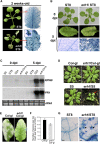An inositolphosphorylceramide synthase is involved in regulation of plant programmed cell death associated with defense in Arabidopsis
- PMID: 19001565
- PMCID: PMC2613663
- DOI: 10.1105/tpc.108.060053
An inositolphosphorylceramide synthase is involved in regulation of plant programmed cell death associated with defense in Arabidopsis
Abstract
The Arabidopsis thaliana resistance gene RPW8 triggers the hypersensitive response (HR) to restrict powdery mildew infection via the salicylic acid-dependent signaling pathway. To further understand how RPW8 signaling is regulated, we have conducted a genetic screen to identify mutations enhancing RPW8-mediated HR-like cell death (designated erh). Here, we report the isolation and characterization of the Arabidopsis erh1 mutant, in which the At2g37940 locus is knocked out by a T-DNA insertion. Loss of function of ERH1 results in salicylic acid accumulation, enhanced transcription of RPW8 and RPW8-dependent spontaneous HR-like cell death in leaf tissues, and reduction in plant stature. Sequence analysis suggests that ERH1 may encode the long-sought Arabidopsis functional homolog of yeast and protozoan inositolphosphorylceramide synthase (IPCS), which converts ceramide to inositolphosphorylceramide. Indeed, ERH1 is able to rescue the yeast aur1 mutant, which lacks the IPCS, and the erh1 mutant plants display reduced ( approximately 53% of wild type) levels of leaf IPCS activity, indicating that ERH1 encodes a plant IPCS. Consistent with its biochemical function, the erh1 mutation causes ceramide accumulation in plants expressing RPW8. These data reinforce the concept that sphingolipid metabolism (specifically, ceramide accumulation) plays an important role in modulating plant programmed cell death associated with defense.
Figures






Similar articles
-
ANNEXIN 8 negatively regulates RPW8.1-mediated cell death and disease resistance in Arabidopsis.J Integr Plant Biol. 2021 Feb;63(2):378-392. doi: 10.1111/jipb.13025. J Integr Plant Biol. 2021. PMID: 33073904
-
Multiple intramolecular trafficking signals in RESISTANCE TO POWDERY MILDEW 8.2 are engaged in activation of cell death and defense.Plant J. 2019 Apr;98(1):55-70. doi: 10.1111/tpj.14199. Epub 2019 Feb 7. Plant J. 2019. PMID: 30552775
-
Arabidopsis 14-3-3 lambda is a positive regulator of RPW8-mediated disease resistance.Plant J. 2009 Nov;60(3):539-50. doi: 10.1111/j.1365-313X.2009.03978.x. Epub 2009 Jul 16. Plant J. 2009. PMID: 19624472
-
PAPP2C interacts with the atypical disease resistance protein RPW8.2 and negatively regulates salicylic acid-dependent defense responses in Arabidopsis.Mol Plant. 2012 Sep;5(5):1125-37. doi: 10.1093/mp/sss008. Epub 2012 Feb 14. Mol Plant. 2012. PMID: 22334594
-
Specific targeting of the Arabidopsis resistance protein RPW8.2 to the interfacial membrane encasing the fungal Haustorium renders broad-spectrum resistance to powdery mildew.Plant Cell. 2009 Sep;21(9):2898-913. doi: 10.1105/tpc.109.067587. Epub 2009 Sep 11. Plant Cell. 2009. PMID: 19749153 Free PMC article.
Cited by
-
Disruption of fumarylacetoacetate hydrolase causes spontaneous cell death under short-day conditions in Arabidopsis.Plant Physiol. 2013 Aug;162(4):1956-64. doi: 10.1104/pp.113.216804. Epub 2013 Jun 6. Plant Physiol. 2013. PMID: 23743712 Free PMC article.
-
The photorespiratory pathway is involved in the defense response to powdery mildew infection in chestnut rose.Mol Biol Rep. 2012 Aug;39(8):8187-95. doi: 10.1007/s11033-012-1666-0. Epub 2012 May 5. Mol Biol Rep. 2012. PMID: 22562382
-
Cloning and characterization of two rice long-chain base kinase genes and their function in disease resistance and cell death.Mol Biol Rep. 2013 Jan;40(1):117-27. doi: 10.1007/s11033-012-2040-y. Epub 2012 Oct 11. Mol Biol Rep. 2013. PMID: 23054004
-
Transcriptome and hormone profiling reveals Eucalyptus grandis defence responses against Chrysoporthe austroafricana.BMC Genomics. 2015 Apr 18;16(1):319. doi: 10.1186/s12864-015-1529-x. BMC Genomics. 2015. PMID: 25903559 Free PMC article.
-
Lipidomic Remodeling in Begonia grandis Under Heat Stress.Front Plant Sci. 2022 Feb 17;13:843942. doi: 10.3389/fpls.2022.843942. eCollection 2022. Front Plant Sci. 2022. PMID: 35251112 Free PMC article.
References
-
- An, Y.Q., McDowell, J.M., Huang, S., McKinney, E.C., Chambliss, S., and Meagher, R.B. (1996). Strong, constitutive expression of the Arabidopsis ACT2/ACT8 actin subclass in vegetative tissues. Plant J. 10 107–121. - PubMed
-
- Balague, C., Lin, B., Alcon, C., Flottes, G., Malmstrom, S., Kohler, C., Neuhaus, G., Pelletier, G., Gaymard, F., and Roby, D. (2003). HLM1, an essential signaling component in the hypersensitive response, is a member of the cyclic nucleotide-gated channel ion channel family. Plant Cell 15 365–379. - PMC - PubMed
-
- Brodersen, P., Petersen, M., Pike, H.M., Olszak, B., Skov, S., Odum, N., Jorgensen, L.B., Brown, R.E., and Mundy, J. (2002). Knockout of Arabidopsis ACCELERATED-CELL-DEATH11 encoding a sphingosine transfer protein causes activation of programmed cell death and defense. Genes Dev. 16 490–502. - PMC - PubMed
-
- Bromley, P.E., Li, Y.O., Murphy, S.M., Sumner, C.M., and Lynch, D.V. (2003). Complex sphingolipid synthesis in plants: characterization of inositolphosphorylceramide synthase activity in bean microsomes. Arch. Biochem. Biophys. 417 219–226. - PubMed
Publication types
MeSH terms
Substances
Associated data
- Actions
- Actions
- Actions
- Actions
- Actions
- Actions
- Actions
- Actions
Grants and funding
LinkOut - more resources
Full Text Sources
Molecular Biology Databases

